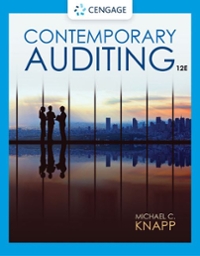Jon Fries orchestrated a large-scale financial fraud that led to the downfall of F&C International. At least
Question:
Jon Fries orchestrated a large-scale financial fraud that led to the downfall of F&C International. At least 10 other F&C executives actively participated in the scam or allowed it to continue unchecked due to their inaction. The methods used by Fries and his cohorts were not unique or even innovative.Fries realized that the most effective strategy for embellishing his company's periodic operating results was to inflate revenues and overstate period-ending inventories. Throughout the early 1990s, F&C systematically overstated sales revenues by backdating valid sales transactions, shipping customers product they had not ordered, and recording bogus sales transactions. To overstate inventory, F&C personnel filled barrels with water and then labeled those barrels as containing highconcentrate flavor products. The company also neglected to write off defective goods and included waste products from manufacturing processes in inventory. Company officials used F&C's misleading financial statements to sell equity securities and to obtain significant bank financing.As F&C's fraud progressed, Jon Fries and his top subordinates struggled to develop appropriate sales and inventory management strategies since the company's accounting records were unreliable. To help remedy this problem, F&C created an imaginary warehouse, Warehouse Q.
Warehouse Q became the accounting repository for product returned by customers for being below specification, unusable or nonexistent items, and items that could not be found in the actual warehouses.2Another baffling problem that faced Fries and his confederates was concealing the company's fraudulent activities from F&C's independent auditors. The executives continually plotted to divert their auditors' attention from suspicious transactions and circumstances uncovered during the annual audits. Subversive measures taken by the executives included creating false documents, mislabeling inventory counted by the auditors, and undercutting subordinates' attempts to expose the fraud.The size and complexity of F&C's fraud eventually caused the scheme to unravel.Allegations that the company's financial statements contained material irregularities triggered an investigation by the Securities and Exchange Commission (SEC). The investigation revealed that F&C had overstated its cumulative pretax earnings during the early 1990s by approximately $8 million. The company understated its pretax net loss for fiscal 1992 alone by nearly 140 percent, or $3.8 million.
1. Jon Fries (CEO), Fletcher Anderson (COO), Craig Schuster (CFO), and Catherine Sprauer (division controller) were the four central figures in this case. Identify the key responsibilities associated with the professional roles these individuals occupied. Briefly describe the type and extent of interaction each of these individuals likely had with F&C's independent auditors.2. Using the scale shown here, evaluate the conduct of the four key individuals discussed in this case. Be prepared to defend your answers.

3. For a moment, step into the shoes of Catherine Sprauer. What would you have done during and following each of the confrontations she had with the two employees who insisted that F&C executives were involved in a fraudulent scheme to misrepresent the company's financial statements?4. Craig Schuster resigned as F&C's CFO on January 1, 1993. Apparently, Schuster did not reveal to any third parties the concerns he had regarding F&C's accounting records and previous financial statements. In your opinion, did Schuster have a responsibility to inform someone of those concerns following his resignation? Defend your answer.5. Assume that you, rather than Fletcher Anderson, were F&C's COO in December 1992. What would you have done upon receiving the list of Warehouse Q inventory from Craig Schuster?
Step by Step Answer:






